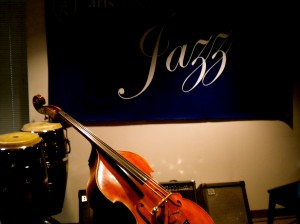Some things worthy of mentioning that are great here is the sparsity near the beginning (45). Knowing the autumn leaves melody makes this much more enjoyable, because you already have the expectation of what it will sound like, and then we he rests for most of it, it is pleasantly surprising. I kinda hear a ghost melody when he rests, which comes from my memory of the melody- it’s a cool effect on its own, but also also the development of contrast as he begins to fill in all that space. This is a good technique that I want to implementing my own solo’s, giving them rom to grow. I appreciate, but am not crazy about all the fast stuff, and throughly enjoy the rhythmic variation.
I liked the sax and piano solo’s too, and especially how the piano used chords and sequences to build intensity.
Category: Video Posts
Epistrophy by Thelonious Monk
http://youtu.be/dZ9El7k4mNo
Herbie Hancock and Roy Hargrove
https://www.youtube.com/watch?v=L9eW6V_Slgs
This is a performance of Butterfly featuring Herbie Hancock and Roy Hargrove and Marcus Miller. One thing I took note of from this performance was the way that Herbie Hancock was comping behind Roy Hargrove (around 6:00). He comes in strong with chord progressions after the each trumpet phrase, and towards the end the measures, rather than the first several beats when Hargrove is creating lines. I’d like to try experimenting more with my comping rhythms and playing around with the harmonies. Herbie’s solo was enjoyable, though I think the synth at 10:45 was unnecessary.
“Wave”; Fast and Slow: connecting ideas
Featured here are both solo trombonists (the masterful Frank Rosolino and Carl Fontana), bass and piano (I thought that was nice for our class. This is a bossa nova in the key of D, and I just love the melody. The countermelody in the second trombone is great it it’s own right too.
I love how the trombonist clearly listen and support each other (I believe one is playing lead and the other is supporting the other, but even playing lead requires you to listen and keep the balance). Here articulation plays a key role in keeping the two lines distinguishable from each other, but also in defining the melody and providing contrast. The smooth parts sound so much smoother after some staccato notes. A hot tub is so much more inviting after a long day.
This song is a song where you can solo in either normal or double time. In my solo’s I have struggled with how to switch between these and integrate them into a larger idea. If you listen carefully, you’ll here clear distinct parts of the solos switch time. The first trombone solo is in double time, and if I’m not mistaken, the rhythm section speeds up with him as the solo gains intensity. It requires complete focus for the band to be able to intensionally speed up together and then reset the tempo. The second trombone solo plays with the two speeds or feels. While I enjoyed the intensity of the first solo, I actually liked the variation and melody of the second solo more. What do you think? I also really liked the bass solo (which includes both speeds.)
http://youtu.be/94qVX-0KrVM
Welcome to the MUS 340 Blog
Welcome to the MUS 340 Jazz Improv II blog for Spring 2015. Here you will find course information and materials to assist you in preparing for each class.
 All students are required to post a weekly video of a jazz performance and provide a brief summary of the event. Please use the previously posted videos as a guide for posting. Students are also encouraged to upload any materials that may contribute valuable insights about jazz improvisation and the topics covered in class. Be sure to visit the blog regularly to receive updates about the course.
All students are required to post a weekly video of a jazz performance and provide a brief summary of the event. Please use the previously posted videos as a guide for posting. Students are also encouraged to upload any materials that may contribute valuable insights about jazz improvisation and the topics covered in class. Be sure to visit the blog regularly to receive updates about the course.
Descendant of Giant Steps- I found one!
This came up on my Pandora station! Smells like Giant Steps. Perhaps their improvisation over the chord changes sounds better than our first time playing it…
Good musicians steal- a familiar theme in a different genre
While working on a jazz arrangement of “Out of Nowhere” for a different class (ahem, Jazz Theory), I ran across this similarly titled piece by Acoustic Alchemy. Perhaps this is a long shot, but I think this is an arrangement of the same song. Here is a more traditional arrangement for comparison. The melody sounds very different, but the chord changes could be the same. Either this song follows a general ABAB’ trend, or it is actually the same song under a thick disguise. Thoughts?
Instructions for Embedding Videos Again
Can someone explain again how to embed videos properly?
Ethiopian Jazz
Has anybody heard of this style of jazz?
Ebo Lala Mulatu Astatke — New York – Addis – London – The Story Of Ethio Jazz 1965-1975
Jazz Influence in Hip-Hop
With Hip-Hop’s sampling tradition, the jazz genre was inevitably going to act as a great resource due to the infinite amount of amazing musical moments that have been recorded. Tracks listed may contain explicit lyrical content.
Curren$y – 04 – Hennessy Beach – (Verde Terrace) (Exclusive)
https://www.youtube.com/watch?v=uS5L9V92WKI
Mac Miller – Traffic In The Sky
This next song takes a direct sample from Nat King Cole’s “Unforgettable” starting at 3:38!
Nas – Can’t Forget About You (featuring Chrisette Michelle)